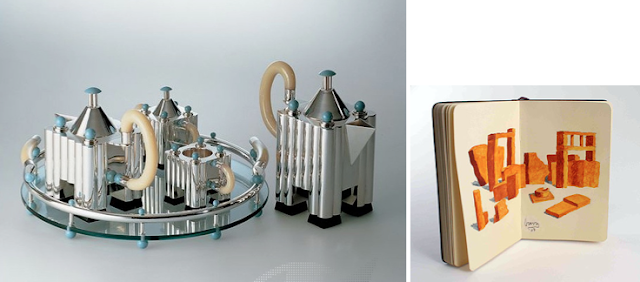 |
| Left: Detail of his famous Alessi kettle, Right: A portrait drawn by Pablo Riestra |
 |
| Some Of Graves best known consumer products, including some kettles, french press, pitcher and kitchen timer |
 |
| Left: Some of Graves silhouettes including a tray, toaster and salt shaker Right: Portland Building, 1982 |
 |
| Left: Portrait of Michael Graves in 1990, Right: His famous kettle for Alessi |
 |
| Some consumer cleaning products produced for Target |
 |
| Left: The Big Dripper, designed in 1995, Right: One of Graves sketches |
 |
| Left: The Thomson Consumer Electronics Headquarters, Indiana, 1992-94 (Now St. Vincent Health) Right: The Steinberger Hotel at El Gouna, Egypt |
 |
| Left: Architectural drawing for a Graves building, Right: Toaster designed by Graves |
 |
| Left: Residence designed by Graves, Right: St Mary's Church of Rockledge, Florida, 2002 |
I remember when I was in Design School in the 90’s, There
was much discussion about Post Modernism as a movement, A very famous and now
sadly deceased Architect Harry Seidler actually came to my University and gave
a speech about the negative effects of Post Modernism on Modern Architecture.
Of course I regarded him as a master and always harbored his influence on my
own impressions even to this day, when it came to Design, He was a Purest and
to a large extent I have thought of myself deep down as one too. He had an obvious
dislike of new Architecture of the time but it seemed inevitable at the time
that this change was going to be part of Architectural history, even if he did
not like it.
At the time, you could not ignore the influence of this new
movement that had sprung up and it’s overpowering impact on new architecture,
something that Sydney at the time was experiencing in a lot of its new
redevelopment urban projects such as Darling Harbour. Of course that was my
world at the time, but Post Modernism was happening all over the world.
One Architect whose influence has been without doubt
amazingly influential is Michael Graves. He is regarded by many as the Post
Modernism king. Identified as one of The New York Five, Graves
has become a household name with his designs for domestic products sold at Target stores in the
United States.
In American Design and
Culture Graves influence is phenomenal, he has designed more than 2,000
consumer products - from toasters to watches to ironing boards - that were sold
exclusively at Target stores. The famous pairing in it’s day helped give Target
a reputation for cheap chic that distinguished it from discount-store rivals
like Walmart and Kmart. They have just parted ways this year,
Some people may argue that his designs seem bulbous and almost cartoon like,
but my impression is that while I maybe a purest at heart who skews towards a
more International style, Graves has contributed a legacy and dedication to
design that is admirable and very distinctive, His work has a sense of whimsy
and humor and extreme relevance to an era that I grew up with and still
continues to dot our skylines, his work and many other Post Modernism works
still form the mesh of current landscapes.
His amazing work for Target aside, his most well known work
for me is his work for Alessi, The Italian company that were leaders in
promoting Post Modernism style and much sought after at that time. My Aunty and
Uncle were the first I knew to have a complete set of Michael Graves Alessi and
as a child I always envied them compared to my parents more traditional tea and
coffee set. They were sought after collector pieces and still are. They came
about following the
successful collaboration on the Coffee and Tea Piazza in 1981. As a result, Alberto
Alessi asked Graves to design a teakettle that would heat quickly,
necessitating a wide base. An arcing handle with a colorful blue insulator
balances the conical shape of the kettle. The addition of the whistling bird, a
reference to the red Indiana roosters familiar to him in his youth, was
Graves's nod to his Midwestern roots. The first product by an American designer
to be included in the Alessi catalogue, Graves's playful teakettle became an
immediate design icon. In continuous production since 1985. Tea and Coffee
themes became a staple of Graves work and you can see many of his most famous
consumer products are for this purpose.
Michael Graves
continues to work out of his practice in New Jersey and on major International
and U.S projects, Check out his work at michaelgraves.com



Hallo Marcus,
ReplyDeleteI was searching for some information about Alessi and I found your Michael Graves post - one of my favorites!
I would like to introduce you to visit my 'Disegno à Milanesa' where I write about architecture, design, interiors, graphic design and my italian lifestyle. I write in portuguese, but u can change the language above, on the right. Translation is not so perfect but you can get what I mean.
Felipe Bastos
www.disegnoamilanesa.blogspot.it
Thanks so much Felipe, I will check it out! Glad you liked my post on Michael Graves! All the best! M.
ReplyDelete